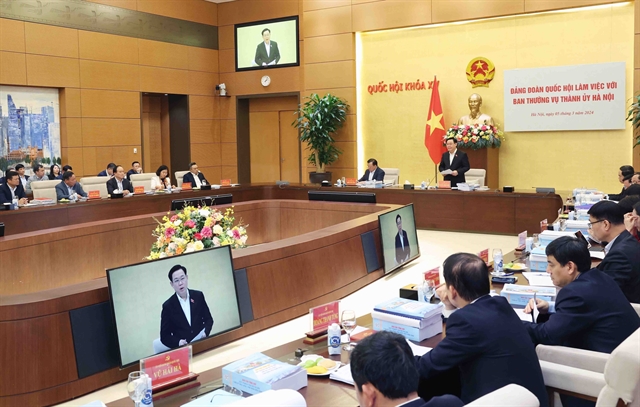 Politics & Law
Politics & Law

 |
| National Assembly Deputy Hoàng Văn Cường from Hà Nội speaks with reporters on the sidelines of the of the 7th session National Assembly. — VNA/VNS Photo |
On the sidelines of the 7th session of the National Assembly discussing certain contents of the draft amended Capital Law, Deputy Hoàng Văn Cường from Hà Nội believes it would create an exceptional legal framework for the development of the capital, addressing existing issues and concerns. He spoke with Tri Thức & Cuộc Sống (Knowledge & Life) online newspaper about the draft.
What is your assessment of the significance of the draft amended Capital Law and the three very important contents, Capital Planning, General Capital Planning and the Capital Law at this session?
The creation of the Capital Law aims to establish an exceptional and distinctive legal framework for the development of the capital, representing the entire nation.
The development of the Capital Law is not just about creating legislation for a developing region, but also about attracting the country's best resources to the capital, making it a representative image for the whole nation.
Regarding the Capital Planning, the General Capital Planning and the Capital Law, I believe this is a rare opportunity to create a breakthrough, providing direction and a legal basis for implementing these orientations. The Capital Planning sets out the general, comprehensive and long-term development directions for the capital, aiming to make it a representative image of the nation comparable to the capitals of other countries around the world.
In the General Planning, specific ideas and special contents about urban infrastructure outlined in the Capital Planning will be detailed. Specific development models and plans will be proposed to shape the future appearance of the capital. To implement these directions and ideas, legal corridors, mechanisms and frameworks are required. This is precisely what the Capital Law provides.
What is the current status of the draft amended Capital Law? Is there anything that concerns you?
I believe the draft amended Capital Law has been fundamentally well-developed. Particularly noteworthy is the spirit of decentralisation, empowerment and assigning responsibility to Hà Nội, enabling it to fulfill its missions and achieve breakthrough development. However, there are still a few areas that require truly clear and exceptional provisions specifically for the capital.
A prominent issue that raises many concerns is the development of the city on both sides of the Hồng (Red) River, transforming it into a central axis for culture, ecology and tourism in the city.
If we maintain the two provisions in the draft law that construction along the riverbanks must comply with the regulations of the Dyke Law, it means that all the riverbank corridors in Hà Nội will be similar to those in other provinces. I believe this is something that needs careful adjustment to provide Hà Nội with a unique mechanism for utilising the banks of the Red River, the Đuống River and other rivers in the area.
Old apartment buildings are considered one of the obstacles to the development of urban Hà Nội. What mechanisms are needed to change this?
We all see the shortcomings in urban development in Hà Nội, which have resulted in regrettable and unforeseeable consequences. In my opinion, the Capital Law and the Capital Planning must aim to address these pressing issues.
Previously, according to legal regulations, many areas within the boundaries of what is called the historic inner city were almost prohibited from undergoing extensive renovation. The restrictions on investment and development in these historic inner-city areas have led to many old apartment buildings remaining unrenovated for years. Numerous self-built houses do not meet technical standards, safety requirements for fire prevention and control or living environment conditions. Yet, there has been no mechanism to renovate or change these conditions.
In the Capital Law, I believe we must establish a legal framework to identify areas that are genuinely conservation zones and historical areas like the Old Quarter, to preserve the historical values of Thăng Long-Hà Nội and important architectural works.
For other areas, we need to implement investment models and renovations based on modern urban standards. The capital cannot develop spontaneously, with residents building according to their subjective intentions rather than following large-scale urban planning standards.
If we achieve this, we will address the current pressing issues, such as spontaneous urban development or residential areas that do not meet standards, and eliminate many shabby areas that are not worthy of the capital.
Clearly, areas that do not meet safety requirements for fire prevention, firefighting, rescue or lack public living spaces must have renovation plans to transform them into zones of modern, civilised development.
What is your assessment of the feasibility of this?
I believe it is entirely feasible. Many of the most disordered and shabby areas are in the city centre, where proper renovation could transform them into zones of high economic value.
The key issue is creating a legal framework that permits change, enabling the utilisation of underground and elevated spaces and developing a modern public infrastructure system, particularly a high-capacity public transportation system like urban railways.
The Capital Planning and the Capital Law both prioritise the development of public transportation systems, especially rail transport. If we achieve this, densely populated areas with many low-rise buildings can be transformed into zones with a few high-rise buildings, elevating living and working spaces. Ground space can then become green areas, public spaces, underground facilities, transportation hubs and service development zones.
Firstly, we need to change perceptions and habits. Currently, everyone wants to live in a ground-level house and is not accustomed to living in high-rise buildings even though living conditions in apartments can be significantly better.
Additionally, we need to change the mechanisms. Urban renovation mechanisms should not only address residents' concerns but also be a responsibility of the State and the Government. There must be investment mechanisms in place. For instance, the State must invest in public transportation infrastructure. Without such investment, we cannot solve the issue of population concentration.
To change people's mindset, habits and living customs, we can offer residents opportunities for transition. If residents agree to move from dilapidated ground-level houses to high-rise apartments, they should be allowed to do so.
The city centre should be planned as a modern development area, not for sprawling ground-level development. By doing this way, there will be no shortage of open spaces for public activities and green urban activities. — VNS




